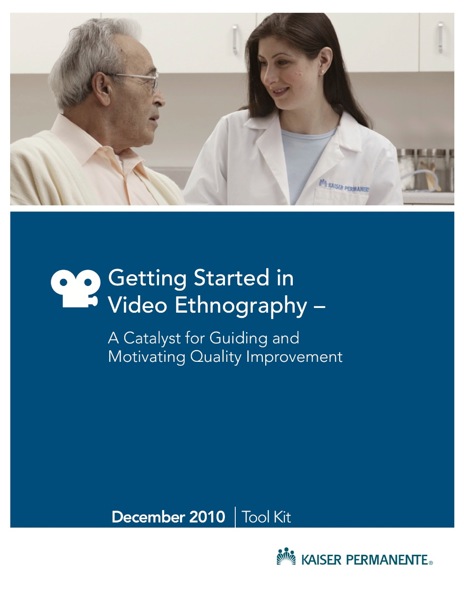“At the end of the interview or observations, thank the participant. Keep the camera rolling—some of the best stories come as the team is walking out the door.”
Being the fan that I am of the patient story and the patient’s voice, I have been drawn to and highly excited by the work of Estee Neuwirth, Ph.D., Jim Bellows, Ph.D., and others at the Kaiser Permanente Care Management Institute in documenting the stories of patients and families using video.
This approach is in some ways different and in some ways similar to some video story work that is available currently on the Kaiser Permanente YouTube Channel. The similarities are the great care taken to respect the patient story and protect their privacy (all of the stories published publicly have thorough consents behind them that are tracked and regularly checked on). The difference is the goal and outcome.
As it says in the kit:
Kaiser Permanente’s Care Management Institute has developed a replicable method for using video ethnography to learn from patient and staff experiences by capturing interviews and observations on videotape, analyzing the footage to identify improvement opportunities, and highlighting them in short videos that reflect the heart of patient experiences. Sharing these videos in dynamic sessions throughout the organization motivates performance im- provement activities and guides them toward areas of greatest opportunity.
In ethnography, it isn’t known what the story will be before it happens, which is what makes it such a great listening tool. The stories themselves can be told in times of great stress. I have seen several of them, and they really are great gifts to patients who want their peers and those who come after them to have the best experiences possible. Several teams are undergoing training in this technique, and its use is expanding. As I like to say, the reality of health care is what is happening where the patient is, and patients are willing to tell us what’s happening – all we have to do is ask.
Ever since learning about this work, I coudn’t wait for there to be shareable resources for other people and organizations interested in learning from their own patients/families/communities. It includes interview guides, planning guides, and tracking tools.
I was delighted both to see Estee this week, and see the publication of this comprehensive toolkit on the Care Management Institute website, for the whole world to access and use. It’s linked above. It will help you listen to the people you serve in a way that will help you and they be great leaders for others.
See what you think, comments welcome, which I’ll pass on to Estee. Her contact information is also in the guide if you would like to connect with her directly.

8 Comments
RT @tedeytan: Now Reading: Getting Started in Video Ethnography – Tool Kit – Kaiser Permanente Care Management http://teyt.in/eVb1iq
Ted– How wonderful that you have shared this resource– We are going to tape a woman vet who has cardiac disease using this tool kit for our web site next week. Clearly, by having woman be the wisdom keeper/sharer of health experience it will impact all of us as better providers and users of the health care system. I'll send it to you when its done. The presence of this tool and your insights encouraged me to try! Kayt
Kayt,
Thanks for posting your intent to use this material! I passed it on to Estee as a great example of how social media can work. Please let me know what happens and what you can show as an example of this technique & see you soon, hopefully!
Ted
Now Reading: Getting Started in Video Ethnography – Tool Kit – Kaiser Permanente Care Management Institute http://t.co/0HmFczg
[…] is a toolkit that was created by healthcare professionals in order to make it easier for people to create […]
[…] themselves. We learned about an example of the latter during a Kaiser Permanente presentation about Video Ethnography(via Ted Eytan’s blog), which films patients during their encounters and uses the footage to […]
[…] Ethnography. is the study and systematic recording of humans in their environments. […]
[…] This is a real technique that complements work to involve patients in the design and operation of the health care system. I have previously posted the link to the CMI Video Ethnography Toolkit – you can find out more about this here: Now Reading: Getting Started in Video Ethnography – Tool Kit – Kaiser Permanente Care Ma…. […]